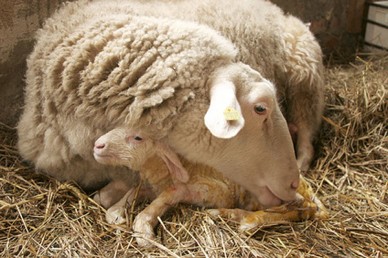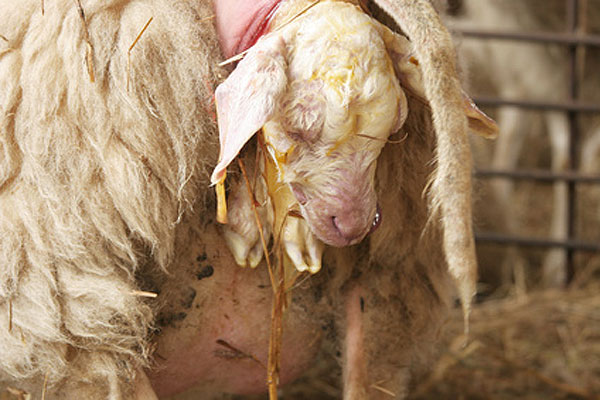Lambing: preparing for your first lambs

According to the National Sheep Association, there are over 32 million sheep in the UK and the numbers are kept topped up every Springtime with up to 15.5million ewes giving birth.
Sheep in the UK are classified into Hill, Upland and Lowland breeds; Hill breeds are those such as the Herdwick, Beulah and Blackface, used to living in mountainous terrain, thriving in bad conditions and with strong mothering instincts. Upland breeds are those such as a Bluefaced Leicester or Kerry and Lowlands include Suffolk, Texel or Charollais.
Most commercial farms will use mules – a cross between a hill and upland. For instance, you may put a Welsh mountain ewe to a Bluefaced Leicester ram which will give a mule that is hardy, with good mothering instincts. These ewes are then put to a Terminal Sire, such as a Charollais, to give lambs which will grow fast and give good carcase characteristics.
The shepherds’ calendar
Generally the shepherds’ calendar starts in September when flushing, the term used for feeding ewes up to bring them to optimum breeding condition, is achieved by either moving them onto fresh new pasture or by feeding concentrates.
The rams (or tups) are usually put with the ewes in October so lambs arrive in March when the worst of the weather is over and the grass is growing through. The oestrus cycle of a sheep is around 3 weeks and it can be advantageous to synchronise the oestrus cycle of larger groups of ewes so all lambs arrive at a similar time. For this purpose a vasectomised or ‘teaser’ ram can be mixed with the ewes to ensure they all become pregnant when served by entire tupps.
To indicate if a ewe has been served, a raddle or chalk is applied to the breast of the ram – this colour then rubs off onto the rump of the ewe. The colour of the raddle is changed every 10 days to ensure the ram is still serving ewes that do not achieve a pregnancy the first time.
Pregnant ewes can be turned out to graze as normal, keeping an eye on their feet and condition until December when you would typically increase their feed intake. Your sheep should be kept in a stress free environment at all times but this is especially important after serving so as to avoid any problems with implanting or reabsorption of the foetus.
Ewes can be scanned with ultrasound mid-pregnancy to give you an idea of how many to expect. In larger operations ewes are usually sprayed with a marker to indicate if they are carrying singles, twins, triplets or more. This is important as ewes carrying differing amounts of lambs may require different amounts of feed – it is also handy to know how just many lambs you are expecting to pull!
In February, in the last third of pregnancy, you will increase the feed intake in line with the strain the growing lambs are putting on the ewe. Lambs grow rapidly in the last 6 weeks of pregnancy so ewes should be closely monitored during this time. Keep an eye out for twin lamb disease (Pregnancy Toxaemia) where overweight ewes carrying multiple lambs can break down their fat stores, releasing ketones from the liver that can cause blood poisoning.
In an ideal situation every breeding ewe would have 2 lambs, this is simply because each has 2 teats although in reality ewes can have singles, triplets or even quads/quins. Larger multiples will usually be separated and adopted onto ewes with a single lamb. Wet adopting should be done as soon as possible after lambing – take a ‘spare’ fresh lamb and adopt it onto a freshly lambed single mother by covering it in the amniotic and parturition fluids. As the ewe licks the lamb clean she will hopefully bond with it and accept it as her own. If this still doesn’t work you could find yourself with some very demanding hand-rearing shifts which, although tiring at the time, are very rewarding when ‘your’ lamb can re-join the flock.
Paturation
Keep a close eye on your ewes as paturation approaches and a few days before lambing you will see a swelling around the vulva and their bags starting to fill with milk. Note: It is usually easiest to observe the group of ewes as they are feeding. When a ewe is ready to lamb she will usually take herself away from the flock to a quiet corner of the pen or field and start nesting. She will often paw at the ground, walk around restlessly and finally lay down starting to strain. This stage can last a good few hours so do not worry if things appear not to be progressing. Thick mucous is often presented, the ewe will be lying down and contractions will be visible on her abdomen and as she strains. Once the water bags are presented the ewe should lamb within the next hour.

The ideal position for giving birth is with nose a front legs coming out first
The ideal presentation for a lamb is a diving position; 2 front feet coming first, closely followed by a nose, this way the lamb is streamlined and can easily fit through the pelvis. However, sometimes you will be presented with a nose, the back legs or, in the case of a breach lamb, just the tail. You will learn from practice and experience how to deal with problem presentations and parturition.
Usually you will aim to correct the position of the lamb and this is normally done by pushing the lamb back into the uterus, feeling and manipulating the limbs to re-correct into the diving position and then birthing the lamb as normal. I sometimes find it easier to close my eyes to concentrate on which joints and limbs I can feel and then work out how to correct the position but initially you would be wise to have a more experienced lamber in attendance so you can benefit from their skills and judgement. In some situations you will need to seek veterinary advice, especially in the case of very large lambs which may need a Caesarian section so always have their number handy and warn them when you are expecting your lambs so they can be prepared should you need to call. It is better to have an experienced lamber around and finish with a healthy lamb and ewe than to struggle on and potentially risk them both.
A more difficult birth with some readjustment of limbs required
Always check a newborn lamb has no membranes or fluid blocking its nose or mouth. Once a ewe has lambed, leave her to lick her lambs dry in order to reduce the risks of hypothermia and to allow them to bond. Shortly after this you will need to step in to disinfect the lambs navel with 7% iodine solution to prevent infections.
It is vitally important to ensure that the lamb has a belly full of colostrum (the first milk) within the first 4 hours. Colostrum is full of antibodies and nutrients needed for the lamb to maintain its body temperature and survive. Lambs are born with a small amount of brown fat which is rapidly burnt and only lasts a few hours. If a lamb hasn’t fed within the first few hours you will need to hold it on to the teat or bottle feed it and the weakest lambs may have to be tube fed every 2-4 hours.
Problems during birthing
There are several problems which can occur during lambing and many of these are related to nutrition and body condition. Sometimes if a ewe is overweight lambs struggle to fit through the pelvis and similarly a rich diet can cause the lambs to grow too large, again causing problems during birth.
Another nutritionally affected problem, or metabolic disease, is Hypocalcaemia (Milk Fever) which usually happens very late in pregnancy. Several factors such as poor nutrition or stress can lead to low blood calcium in the ewe. Affected ewes are often found sitting in the pen or having problems walking, unable to lift their head and frothing at the mouth. Calcium and dextrose can be injected under the skin (subcutaneously – not into the muscle) spread over 4 injections across the body; massage the injection site to allow it to absorb more efficiently into the bloodstream.
Lambing kit
As well as iodine and colostrum there will be a few other essential items you should have in your ‘lambing kit’ to cover possible eventualities. Everyone will have their own ideas but this might contain clean towels to dry lambs and stop them catching a chill, colostrum tube and syringe, lambing rope or bailer twine, disposable gloves and lubricant (in case you have to lend a hand) and castration rings and applicator. Note: castration with rings is a simple procedure that should be done early and definitely within the first week of life – the procedure should be carried out or overseen by someone with experience for the first few applications.
Ewes and lambs can be sprayed with corresponding ID numbers to allow you to reunite families should they get separated in their first few days in the fields. Note: I always spray sheep on their left hand side so when they are herded with a sheepdog the ID numbers all face us as the flock runs past.
Many thanks to Lewis Wescott, aka Dr Chicken, for this article. You can follow Lewis on Twitter @DrChicken
Livestock categories
Most recent Livestock articles
- How to Maintain Your Paddock 09th September, 2017
- Absolute beginner’s guide to breeding sheep 05th November, 2016
- Absolute beginner’s guide to keeping sheep 02nd October, 2016
- Beginning back garden beekeeping 06th September, 2016
- Mini Moos: The world’s most popular beef cattle ‘repackaged’ for smallholders 24th August, 2015
- Iron Age Pigs: this boar is no bore 04th August, 2015







Leave a reply